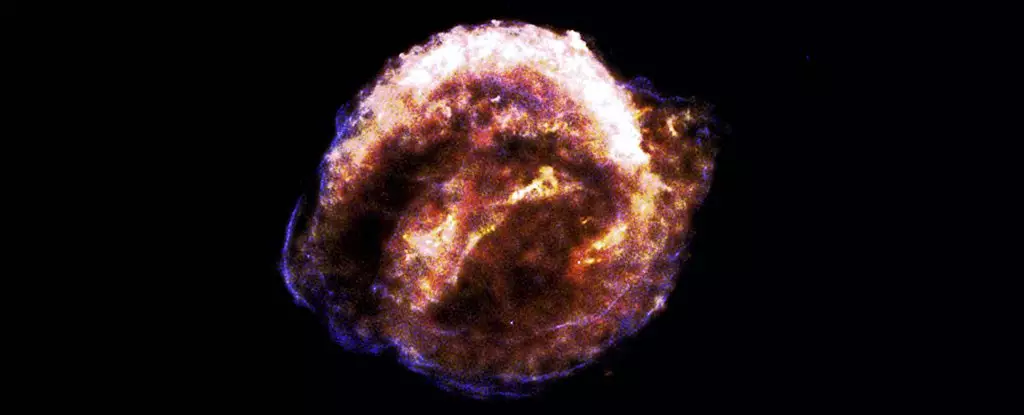Supernovae, the colossal explosions marking the death throes of massive stars, are more than just celestial fireworks; they are the universe’s forge for heavy elements. This cataclysmic event produces and expels elements such as iron into the cosmos at unfathomable energy levels. On Earth, the remnants of these ancient explosions linger in our geological record. They are embodied in the isotopes found in seafloor sediments, specifically the rare isotope Fe60. Researchers have pinpointed two notable accumulations of Fe60 that can be traced back approximately two to three million years and five to six million years, revealing the profound impact supernovae have had on our planet’s elemental composition.
The resonance of supernovae is particularly significant as it introduces a surge of cosmic radiation to Earth. Recent inquiries, particularly a compelling study featured in the Astrophysical Journal Letters, led by Caitlyn Nojiri from UC Santa Cruz, delve into how these cosmic events affect terrestrial life. The study proposes that the radiation emitted by nearby supernovae—characterized as having the potential to heighten radiation levels by several orders of magnitude—could have affected the course of evolution itself. Given that life on Earth exists within a continuum of ionizing radiation, the intermittent increases from nearby supernovae could serve as both a catalyst and a challenge for the organisms inhabiting our planet.
The Local Bubble: An Interstellar Playground
To fully grasp the implications of surrounding cosmic activity, we must consider the context of the Local Bubble, a vast region of space generated by multiple supernova occurrences. This bubble, home to our Solar System, is nearly 1,000 light-years across and was formed over millions of years by the explosive deaths of stars. The paper’s authors assert that our Solar System’s passage through this bubble correlates with the specific layers of Fe60 found in ancient sediments. The younger accumulation appears to be a direct result of a supernova explosion, while the older accumulation aligns with the Solar System’s entry into this heated, dynamic cosmic environment.
Despite difficulty in definitively quantifying the biological impact of supernova radiation, it is hypothesized that the energy could have led to significant changes in genetic material, potentially causing DNA double-strand breaks. These breaks represent a severe form of genetic damage that can trigger mutations and drive evolutionary change. Intriguingly, an uptick in viral diversification noted in a recent study regarding the African Tanganyika lake suggests a possible connection to the increase in cosmic radiation around the same time as these supernova events. Thus, the relationship between supernova radiation and biological diversity appears to be complex and multi-faceted, prompting further exploration into how fluctuations in cosmic radiation levels might have shaped the evolutionary landscape on Earth.
The Threshold of Cosmic Radiation: Harmful or Beneficial?
Cosmic radiation is a perpetual aspect of the terrestrial environment, its levels fluctuating based on the Solar System’s movements through the galaxy and the occurrence of cosmic events. While it is established that radiation can instigate changes in biological systems, determining what thresholds classify radiation as harmful or beneficial to evolution remains a crucial question. The authors acknowledge the ambiguity in understanding the precise biological effects exerted by cosmic radiation, particularly the muons, which dominate the energetic landscape at ground level. Such uncertainties emphasize the nuanced interaction between environmental factors and life on Earth.
As we contemplate the cosmos and our place within it, a provocative notion surfaces: supernovae, those distant celestial giants, may have played an instrumental role in shaping the course of terrestrial life. The mutations catalyzed by sporadic increases in cosmic radiation could lead to diversification at key evolutionary moments, illustrating how interconnected we are with the universe. While we may not fully understand the myriad complexities of cosmic radiation and its implications, it is clear that our existence may hinge upon a broader cosmic context—one in which supernovae serve as powerful agents of change.
The study reminds us that the influences shaping life on Earth are not only terrestrial but also cosmic in origin. Understanding the legacies of such explosions provides profound insights into the delicate tapestry of evolution and the myriad factors that make life on our planet possible. As we explore the cosmos further, we must consider how these celestial phenomena will continue to shape our biological future.


Leave a Reply